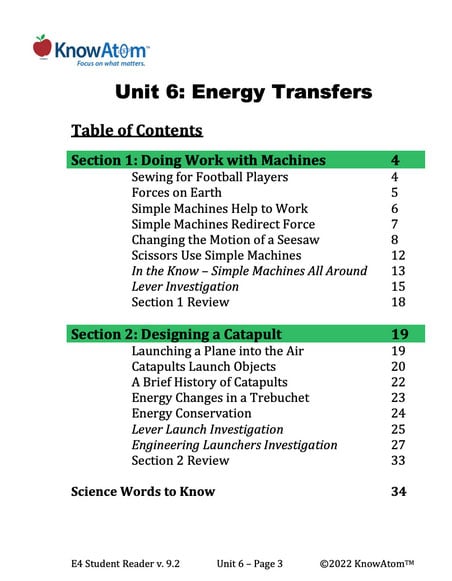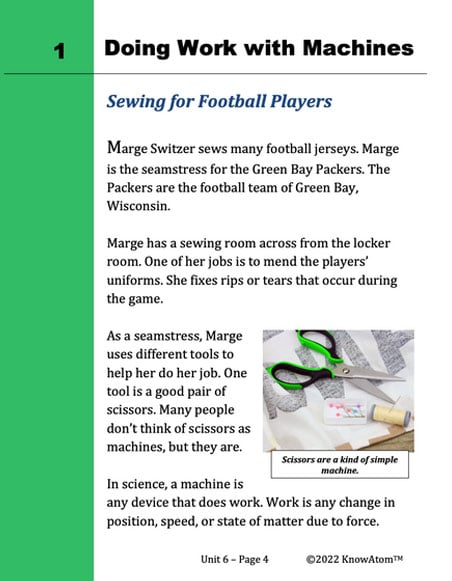Students use their scientific knowledge of levers, forces, and energy to design and test a prototype to launch objects.
In this unit, students explore the phenomena of forces, energy, and motion in systems involving simple machines. In this lesson, students solve a problem by prototyping solutions to launch objects. This page highlights each component of this lesson.
The science background section gives teachers more in-depth information on the phenomena students explore in this unit about forces and motion. Below is an excerpt of the science background information about engineering launchers.
Engineers have designed catapults to launch planes off of the deck of an aircraft carrier, where there isn’t enough space for the long runway used by planes taking off from the land.
People have been using catapults since the time of the ancient Greeks. One common ancient catapult was a trebuchet, which is a type of Middle Age device that used a lever and a sling to throw heavy stones at enemy castles or walls.
The trebuchet moves in a similar way to a seesaw. One end moves up as the other end moves down. However, there are some differences. The first is that the fulcrum isn’t halfway between the effort force and the load, as it is in a seesaw. Instead, the fulcrum in a trebuchet is located closer to the side where the effort force will be applied. This effort force comes from a heavy weight, called a counterweight, that is attached to the short arm of the lever.
The load, or object to be launched, is on the opposite side. It is usually placed in a sling transform gravitational at the very end of the long arm of the lever. Trebuchets use a lever to potential energy into kinetic energy, which is used to launch objects.
Trebuchets are able to launch heavy objects like rocks because they change gravitational potential energy into kinetic energy.
This gravitational potential energy comes from the counterweight. When the counterweight is pulled up off of the ground, it gains gravitational potential energy. The higher off the ground it is, the more energy it stores. Also the more massive it is, the more energy it stores.
When the counterweight is dropped to the ground, gravity pulls down on it, causing the gravitational potential energy to change into kinetic energy. This kinetic energy pulls down on the lever, causing the long arm on the other side of the fulcrum to move up as the short arm is pulled to the ground. As the long arm moves up, it launches the sling holding the load. Because of the conservation of energy, the more potential energy a catapult can store, the more kinetic energy it will have to hurl its load.
When engineers design catapults, they need to think about energy conservation and the form of potential energy they want to use to change into kinetic energy. They also need to think about how friction transfers energy out of systems. Because friction occurs wherever two objects rub against each other, engineers need to try to reduce friction at points where two objects come into contact with one another. This is because they want the maximum amount of potential energy available to change into kinetic energy. Engineers often have to test multiple prototypes, looking for ways to increase the energy their design can store and change into kinetic energy.
Students use their scientific knowledge of levers, forces, and energy to design and test a prototype to launch objects.

Prepared hands-on materials, full year grade-specific curriculum, and personalized live professional development designed to support mastery of current state science standards.
Catapult: a machine that changes potential energy to kinetic energy so it can launch objects into the air
Effort force: the force you apply to a machine
Launch: to throw something with a lot of force
Load: an object that a simple machine moves or the force that the simple machine must overcome

Catapults Launch Objects
A catapult is a machine that changes potential energy to kinetic energy so it can launch objects into the air. To launch means to throw something with a lot of force.
Remember that energy can either be stored or in motion. Energy that is stored is called potential energy. The energy of motion is called kinetic energy.
There are different forms of potential and kinetic energy. Chemical energy is one form of potential energy. It is stored in the bonds that hold together atoms and molecules. All moving objects, from a moving car to a running dog, have kinetic energy.
Catapults can use different forms of potential energy. For example, some fishermen use catapults to launch bait into the water. Bait is used to attract the fish they want to catch.
The catapults used by fishermen are simple. They are made up of a kind of rubber band. This rubber band stores elastic energy. Elastic energy is a form of potential energy. It is stored in objects when they’re stretched. The more the rubber band is stretched, the more elastic potential energy it stores.
In the catapult used in fishing, the bait is placed at the end of the rubber band. When the rubber band is released, the elastic potential energy changes to kinetic energy. This energy launches the bait into the water.
A Brief History of Catapults
People have used catapults since the time of the ancient Greeks. One common ancient catapult was called a trebuchet. A trebuchet used a lever and a sling to throw heavy stones at enemy castles or walls.
The trebuchet moves in a similar way to a seesaw. One end moves up as the other end moves down.However, there are some differences. The first difference is that the fulcrum isn’t halfway between the effort force and the load, as it is in a seesaw. Instead, the fulcrum in a trebuchet is located closer to the side where the effort force will be applied. This makes one side of the lever arm shorter than the other. There is a heavy weight called a counterweight. It is attached to the short arm of the lever.
The load is the object to be launched. It is on the opposite side of the fulcrum. It is usually placed in a sling at the very end of the long arm of the lever.


Energy Changes in a Trebuchet
Trebuchets launch heavy objects like rocks because they change gravitational potential energy into kinetic energy.
This gravitational potential energy comes from the counterweight. When the counterweight is pulled up off of the ground, it gains gravitational potential energy. The higher off the ground it is, the more energy it stores. Also the more massive it is, the more potential energy it has.
When the counterweight is dropped to the ground, gravity pulls down on it. This causes the gravitational potential energy to change into kinetic energy. This kinetic energy pulls down on the lever. This causes the long arm to move up as the short arm is pulled to the ground. As the long arm moves up, it launches the sling holding the load.
In this lesson, students explore the phenomena in kinetic systems by identifying an engineering problem, including its criteria and constraints, that they will then design a technology to solve. Students create a visual model of their prototype before they build it hands-on and test how far their prototype throws balls in the context of an automated kennel. Students evaluate each prototype for effectiveness and possible failure points as they consider ways to improve it.
KnowAtom incorporates formative and summative assessments designed to make students thinking visible for deeper student-centered learning.

Standards citation: NGSS Lead States. 2013. Next Generation Science Standards: For States, By States. Washington, DC: The National Academies Press. Neither WestEd nor the lead states and partners that developed the Next Generation Science Standards were involved in the production of this product, and do not endorse it.